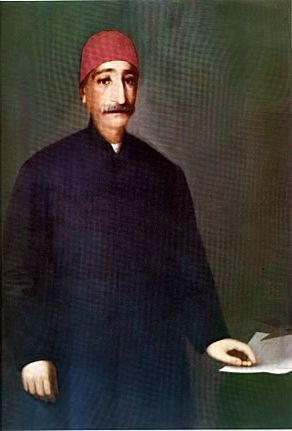Garabed Amira Balyan (1800 – 1866)
 Garabed Amira Balyan was the son of Kirkor Amira and the father of Nigoğos, Agop, Sarkis and Simon. He was born in Istanbul in 1800. Garabed had eleven children: six boys and five girls, by his first wife, Nazemi, and two children, a boy and a girl by his second wife Maritsa. After his father Kirkor’s death, Garabed was appointed as imperial architect by Sultan Mahmud II at the age of thirty one. Garabed Amira worked first as a team with his brother-in-law Ohannes Amira Serverian and subsequently with his eldest son Nigoğos Bey.
Garabed Amira Balyan was the son of Kirkor Amira and the father of Nigoğos, Agop, Sarkis and Simon. He was born in Istanbul in 1800. Garabed had eleven children: six boys and five girls, by his first wife, Nazemi, and two children, a boy and a girl by his second wife Maritsa. After his father Kirkor’s death, Garabed was appointed as imperial architect by Sultan Mahmud II at the age of thirty one. Garabed Amira worked first as a team with his brother-in-law Ohannes Amira Serverian and subsequently with his eldest son Nigoğos Bey.
His most renowned works is Dolmabahçe, which was completed in 1856 and is one of Istanbul’s most ostentatious and beautiful buildings. During the three reigns of Sultan Mahmud II, Abdülmecid and Abdülaziz, Garabed maintained his reputation by adapting not only to the personal tastes of these sultans, but also to the changing values of his age. The most productive period of his career coincides with the reign of Abdülmecid (r: 1839-1861). During his nearly thirty years as imperial architect, Garabed built seven palaces and kasırs, four factories, a barracks, a mosque, seven churches, two hospitals, three schools, two reservoirs, a sebil (kiosk for dispensing free drinking water), and a tomb.
Most of these buildings are still standing today largely in their original state, and most are under first degree conservation orders. Basically Garabed’s buildings can be divided into two categories by style. His early works is irrefutably classical. Plans consists of squares and rectangles arranged in definite geometrical relationships, messes are proportional, flat surfaces are largely free of embellishment, windows are round-arches or have pediments, moldings are curved or angled; altogether creating a neoclassical style which Garabed Balyan employed most consistently for the longest time. Examples of this style include the palaces of Cemile Sultan and Münire Sultan, Dolmabahçe Mosque, the War College and New Reservoir.
In 1836, Garabed Amira and his brother-in-law Ohannes Kalfa were awarded all the privileges previously conferred upon Kirkor Amira. In 1844, Garabed was permitted to wear a fez bearing the sultan’s monogram. In 1845, Sultan Abdülmecid, who was determined to industrialize his empire, presented Garabed with the Nişan-ı İftihar medal and a valuable box as expressions of appreciation for his construction on time of the iron and steel works at Zeytinburnu. As well as being involved in community politics, Grabed Kalfa was active in its cultural and educational affairs. He and Ohannes Kalfa met the expenses of the Cemaran College, which they had established in Üsküdar in 1838 as long as it remained open, and he opened a school for agricultural technicians beside the Armenian Church of St. Saviour in Yedikule in 1854.
On 15 November in 1866, he died of a heart attack while conversing with friends in his mansion in Beşiktaş. He was buried in the Armenian Cemetery in the same district.
The list of his important works:
- Altınizade Necib Bey Waterfront House, Kandilli
- Bakırköy Cotton Mill (Basmahanesi)
- New Reservoir (Bend-i Cedid)
- St. Mary’s Church, Beşiktaş
- Jemaran School (Cemaran Mektebi)
- Cemile Sultan and Münire Sultan Palaces
- Çirağan Palace (old)
- Dolmabahçe Bezmiâlem Valide Sultan Mosque
- Dolmabahçe Palace
- Dolmabahçe Clock Tower
- Gümüşsuyu Military Hospital
- Gümüşsuyu Barracks (Kışlası)
- Hereke Imperial Textile Mill
- İzmit Broadcloth Mill (çuhahanesi)
- İzmit Imperial Kasrı
- Kirazlı Reservoir (Bendi)
- Kuleli Cavalry Barracks (Süvari Kışlası) (Çengerköy Barracks)
- Imperial Engineering College (Mühendishane-i Berrî-i Hğmayun)
- Kuruçeşme Armenian Church of the Holy Cross
- The Imperial War Academy (Mekteb-i Harbiye)
- Imperial Medical School (Mekteb-i Tıbbiye-i Şâhâne) (Today’s Galatasaray High School)
- Armenian Church of the Holy Trinity
- Yıldız Pavilion (Köşkü)
- Saint Saviour’s Armenian Hospital
- Armenian Church of Saint Saviour
- Zeytinburnu Iron and Steel Factory
Some selected examples (please click on pictures to enlarge):








